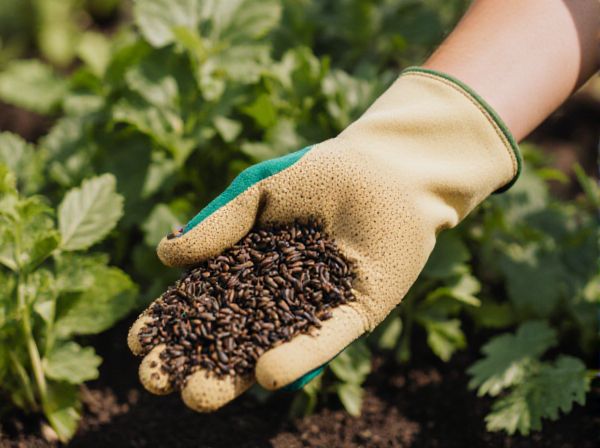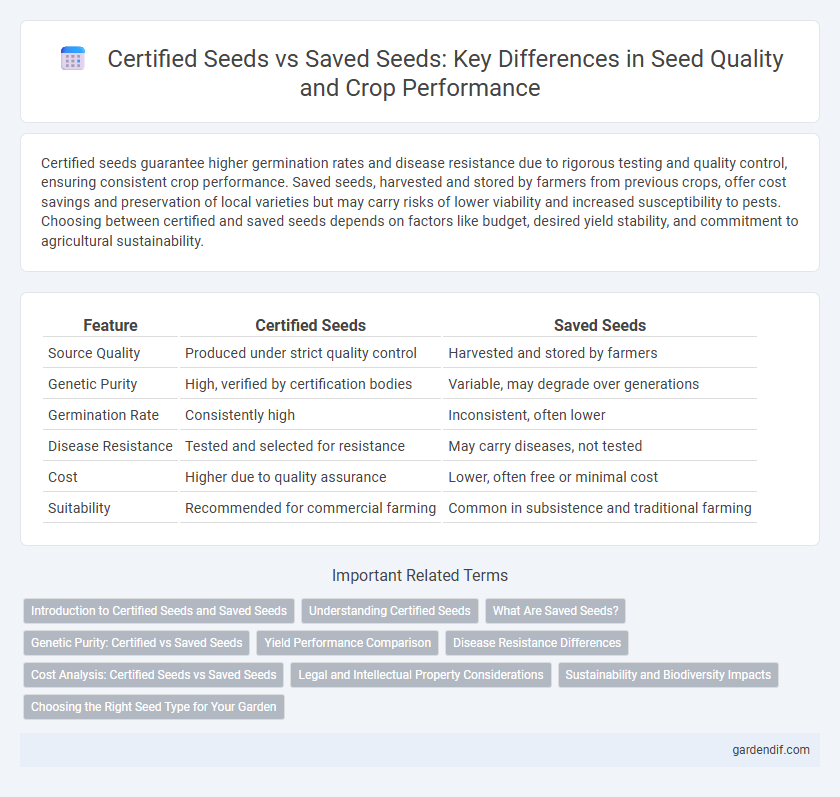
Certified seeds vs Saved seeds Illustration
Certified seeds guarantee higher germination rates and disease resistance due to rigorous testing and quality control, ensuring consistent crop performance. Saved seeds, harvested and stored by farmers from previous crops, offer cost savings and preservation of local varieties but may carry risks of lower viability and increased susceptibility to pests. Choosing between certified and saved seeds depends on factors like budget, desired yield stability, and commitment to agricultural sustainability.
Table of Comparison
| Feature | Certified Seeds | Saved Seeds |
|---|---|---|
| Source Quality | Produced under strict quality control | Harvested and stored by farmers |
| Genetic Purity | High, verified by certification bodies | Variable, may degrade over generations |
| Germination Rate | Consistently high | Inconsistent, often lower |
| Disease Resistance | Tested and selected for resistance | May carry diseases, not tested |
| Cost | Higher due to quality assurance | Lower, often free or minimal cost |
| Suitability | Recommended for commercial farming | Common in subsistence and traditional farming |
Introduction to Certified Seeds and Saved Seeds
Certified seeds undergo rigorous testing and certification processes to guarantee genetic purity, high germination rates, and freedom from diseases, ensuring consistent crop performance. Saved seeds are harvested from previous crops by farmers, often exhibiting genetic variability and potential disease carryover, which can affect yield reliability. Choosing certified seeds supports uniform crop growth and higher productivity, while saved seeds offer cost savings but with increased risks of reduced quality.
Understanding Certified Seeds
Certified seeds undergo rigorous testing and quality control processes to ensure genetic purity, high germination rates, and freedom from disease, making them a reliable choice for optimal crop yield. These seeds meet official standards set by agricultural authorities and provide farmers with uniformity and consistency in crop performance. Using certified seeds reduces risks associated with pest infestations and poor seed viability compared to saved seeds, enhancing overall farm productivity.
What Are Saved Seeds?
Saved seeds refer to seeds that farmers collect and store from previous harvests for future planting, often selected for traits like adaptability and resilience. Unlike certified seeds produced under strict quality controls and tested for genetic purity, saved seeds may vary in germination rates, disease resistance, and uniformity. Despite potential inconsistencies, saved seeds remain a vital resource for subsistence farmers seeking cost-effective and locally adapted planting material.
Genetic Purity: Certified vs Saved Seeds
Certified seeds maintain high genetic purity through rigorous testing and controlled production processes, ensuring uniformity and optimal crop performance. Saved seeds, while cost-effective, often exhibit genetic variability due to environmental influences and potential cross-pollination, leading to inconsistent traits in subsequent generations. Farmers seeking reliable yields and disease resistance typically prefer certified seeds for their documented genetic integrity.
Yield Performance Comparison
Certified seeds consistently deliver higher yield performance compared to saved seeds due to rigorous quality control, disease resistance, and genetic purity ensured during production. Studies indicate that farmers using certified seeds achieve yield increases of 10-30% over those who rely on saved seeds, which often suffer from reduced viability and increased susceptibility to pests. The standardized germination rates and enhanced trait stability in certified seeds directly contribute to improved crop productivity and profitability.
Disease Resistance Differences
Certified seeds undergo rigorous testing and certification processes to ensure high levels of disease resistance, reducing the risk of crop loss. Saved seeds, often harvested from previous crops without formal testing, carry a higher risk of harboring pathogens, which can lead to increased susceptibility to diseases. Using certified seeds enhances crop health and yield stability by minimizing exposure to seed-borne diseases.
Cost Analysis: Certified Seeds vs Saved Seeds
Certified seeds typically have higher upfront costs due to rigorous testing, quality assurance, and certification fees, ensuring genetically pure and disease-free plants. Saved seeds reduce immediate expenses by recycling seeds from previous harvests but may incur hidden costs related to lower germination rates, potential disease transmission, and yield variability. Analyzing total cost-effectiveness involves balancing the initial investment of certified seeds against the long-term risks and variability associated with saved seeds.
Legal and Intellectual Property Considerations
Certified seeds comply with established quality standards and legal regulations, ensuring protection under intellectual property laws such as plant variety protection (PVP) and patents. Saved seeds, typically harvested and reused by farmers, often face restrictions due to seed sovereignty laws and intellectual property rights held by seed companies, which may limit their legality and use. Farmers must navigate complex legal frameworks to avoid infringement and secure rights for saving or exchanging seeds.
Sustainability and Biodiversity Impacts
Certified seeds undergo rigorous quality control, ensuring high germination rates, disease resistance, and uniformity, which supports sustainable agricultural productivity. Saved seeds, often reused from previous harvests, promote biodiversity by preserving genetic diversity and adapting to local environmental conditions. Relying solely on certified seeds can reduce crop genetic variation, potentially impacting ecosystem resilience and long-term sustainability.
Choosing the Right Seed Type for Your Garden
Certified seeds are rigorously tested for purity, germination rate, and disease resistance, ensuring consistent crop quality and yield, making them ideal for gardeners seeking reliability and uniformity. Saved seeds, collected from previous harvests, offer adaptability to local conditions and cost savings but may carry genetic variability and higher risk of disease transmission. Selecting the right seed type depends on your garden's goals, whether prioritizing guaranteed performance with certified seeds or embracing biodiversity and cost-efficiency with saved seeds.
Certified seeds vs Saved seeds Infographic

 gardendif.com
gardendif.com